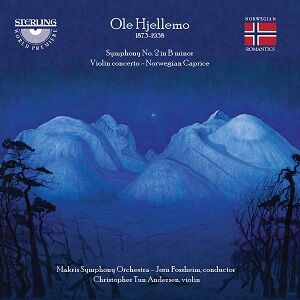
Ole Hjellemo (1873-1938)
Violin Concerto (1933)
Norwegian Caprice (Rondo) for violin and orchestra (1935)
Symphony no.2 in B minor (1922-26)
Christopher Tun Andersen (violin)
Makris Symphony Orchestra/Jørn Fossheim
rec. 2022, Zadužbina Ilije Kolarca, Belgrade, Serbia
Sterling CDS 1128-2 [74]
I stand to be corrected but, as far as I know, this is the only recording of Ole Hjellemo’s music in the catalogue, apart from a mention in the accompanying booklet notes of an arrangement of a small piece for brass band said to have been recorded. I couldn’t find any trace of it. Strange, really, that it’s taken so long for a composer of five symphonies, other symphonic works, a quartet, a violin concerto and choral music to have finally been represented on CD. It is indeed very welcome.
Hjellemo hailed from Dovre in the centre of Norway, now in the Rondane National Park. It’s a mountainous area of impressive landscapes. He grew up on a farm and from early on was exposed to the country’s rich folk music tradition. Musical talent manifested itself early and he learned to play the violin. Aged 20 he relocated to Kristiania, now Oslo. The only door open to him at the time was to join the army as a way of learning music; eventually he could play several instruments including wind, percussion and piano. He directed the Dombås Music Society from 1895 to 1906. As time passed he was able to study under Gudbrand Bøhn and Iver Holter. He played the violin in orchestras, and retired from the army in 1930. From 1919 to 1932 he taught violin, harmony, and composition at the Oslo Conservatory. He died in Oslo in 1938.
The earliest work here in the Second Symphony in B minor, written between 1922-1926. Hjellemo’s First Symphony of 1912 had been disparaged by the critics, hence the lapse of some ten years before he felt confident enough to present its successor to the public. Scored for large orchestra, it was premiered in 1926. It’s an epic and ambitious work which struts out with confidence and depicts a mountain climb in Norway. The opening movement seems inspired by the mountainous landscapes that surrounded him, and some of the brass sections remind me of Wagner. Everything appears writ large. A much less grandiose slow movement follows. The composer described it as “mist and emerging sunshine through skies”. The disposition is mysterious, lyrical and elemental, with some glorious pastoral whispers from the woodwind. The third movement is, to all intents and purposes, a scherzo which contrasts moments of invigorating freshness with more solemn moments. Pizzicatos usher in the finale. The theme is of descent from the mountain. Rivers, waterfalls and birch-tree groves all make an appearance, according to the composer’s description.
The first mention of the Violin Concerto is on a concert programme in May 1934 when the composer conducted a performance with the Philharmonic Company Orchestra. The soloist on that occasion was Johan Simonsen, later to become a member of the Boston Symphony Orchestra. The structure of the work is unusual, with the opening movement 2/3 the total length of the work, and the finale only lasting just over 3 minutes. The first inhabits sunny pastures and exudes a comforting warmth. The Andante has a melancholic introspection. I find it the most interesting and finest of the three movements. It employs some vivid colourful orchestration, around which Christopher Tun Andersen weaves a luminous web of sound. The finale follows without a break. I thought it the least distinguished of the movements. Nevertheless, it brings the work to a resounding conclusion.
The Norsk Caprice was premiered in June 1936 and was graced with several performances after the composer’s death. Hjellemo originally titled it Rondo for violin and orchestra, but later changed it to Norsk Caprice. It’s based on a traditional Norwegian Halling, which is a folk dance. The fact that Hjellemo was a violinist himself is reflected in the virtuoso writing of the solo part. There are numerous double-stop passages, for instance. It’s an attractive score of catchy rhythms, with plenty of swirl and swing.
All three of these rare works are superbly recorded and receive excellent and persuasive performances. As is the norm with Sterling, they are spectacularly well documented. The liner notes are written by the conductor of these works, Jørn Fossheim. Don’t miss this disc if you are well disposed to tonally pleasing late Romantic music.
Stephen Greenbank
Previous review: Jonathan Woolf (January 2023)
Help us financially by purchasing from




















